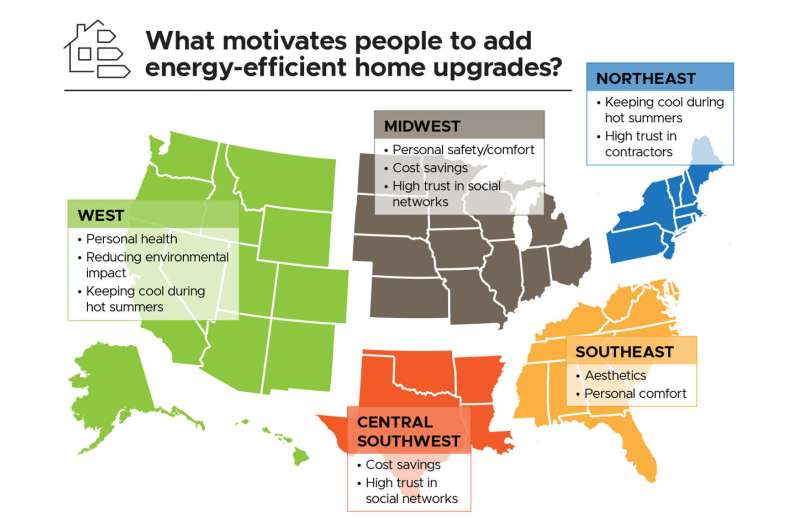This article has been reviewed according to Science X's editorial process and policies. Editors have highlighted the following attributes while ensuring the content's credibility:
fact-checked
peer-reviewed publication
trusted source
proofread
Motivation behind energy-efficient upgrades differs by location

With several billion dollars available from the Inflation Reduction Act for upgrades to increase energy efficiency of the home, now is the time for consumers to take advantage of federal government subsidies that will help lower their energy costs and carbon footprint while increasing comfort in their homes.
But first, people need to feel motivated to make these changes.
In a national survey of more than 10,000 people, published in Energy Policy, researchers at Pacific Northwest National Laboratory (PNNL) found that motivators such as personal health, environmental impact, aesthetics, cost, and more differ widely across the United States. Understanding these motivations can help policymakers and organizations running energy rebate programs help reach those interested in making energy-efficient upgrades.
"There's a big difference between aspirations for adopting energy-efficient technology and actual adoption," said Chrissi Antonopoulos, a residential building analyst at PNNL and the study's lead author. "It's been a problem for a long time, and our goal with this survey was to understand what's driving the behavior and decision-making in households."
First and foremost, the study found that upfront cost is the largest barrier for people who want to make energy-efficient upgrades, like installing heat pumps. People who rent apartments or houses have an especially high barrier to upgrading their homes because they depend on the building's owner to make decisions about renovations or large appliances.
The study also found that most people upgraded to their homes to improve comfort and safety, changing spaces to be more useful, reducing energy bills, and reducing maintenance effort or cost.
However, researchers also found that different goals motivate people in different parts of the country. Understanding these differences can help policymakers better reach consumers—especially now that financial assistance is available for many.
Regional motivators for energy-efficient upgrades
In the West, people are motivated by personal and environmental health, the study found. As climate change drives hotter summers in the West, more and more people are installing air conditioners for personal comfort and safety. To encourage more energy-efficient upgrades in the West, the study found that it's important to provide information about the carbon emissions associated with each cooling option.
"We can say with confidence that people in the western United States care about the health impacts, environmental impacts, and the carbon footprint of their home," Antonopoulos said.
Motivators in the West also included making changes to improve spaces like home offices, craft rooms, or kitchens.
In the Midwest, the study found that homeowners and renters are motivated by cost-saving measures and personal safety within the home. Policymakers in the Midwest should make sure that consumers understand that energy-efficient technology or renovations could make a home more resilient to bad weather or power outages.
In the Southeast, survey respondents tend to value the curb appeal of their homes, as well as interior aesthetics. To reach consumers here, the researchers suggest working with home builders and contractors to fold information about energy-efficiency upgrades into discussions about remodeling a bathroom or kitchen.
To tease out these regional differences, the survey asked respondents about what parts of their home they value most and what factors lead to changes, such as improving comfort or changing aesthetics. This way, researchers could get a sense of what homeowners find important about their lives and look for ways that energy-efficient technology can fit in.
"Instead of asking how decarbonization technology can help someone, we want to know: What are your needs, and how do you use technology to fill those needs?" Antonopoulos said.
Reaching consumers, future work
The survey also asked about trusted sources of information, which also revealed regional differences. In the Midwest and Central Southwest, for example, people tended to place more value on their social networks, while people in the Northeast put more trust in contractors.
Across the board, however, respondents noted that they turn to big box stores (such as home improvement, home goods, or technology chains) for information about energy-efficient upgrades. Groups trying to encourage people to adopt energy-efficient technology "should focus on reaching customers through their trusted sources of information," Antonopoulos said, perhaps by partnering with national home improvement retailers or contractors to reach homeowners.
Looking at regional motivators was just the first step for the work. Next, Antonopoulos and the research team will look through the data to pull out socioeconomic factors that may hinder adoption of energy-efficient technology.
"If you have this one-size-fits-all approach to decarbonizing homes, you're likely to miss opportunities to encourage technology uptake," Antonopoulos said.
More information: Chrissi A. Antonopoulos et al, Regional assessment of household energy decision-making and technology adoption in the United States, Energy Policy (2023). DOI: 10.1016/j.enpol.2023.113940


















